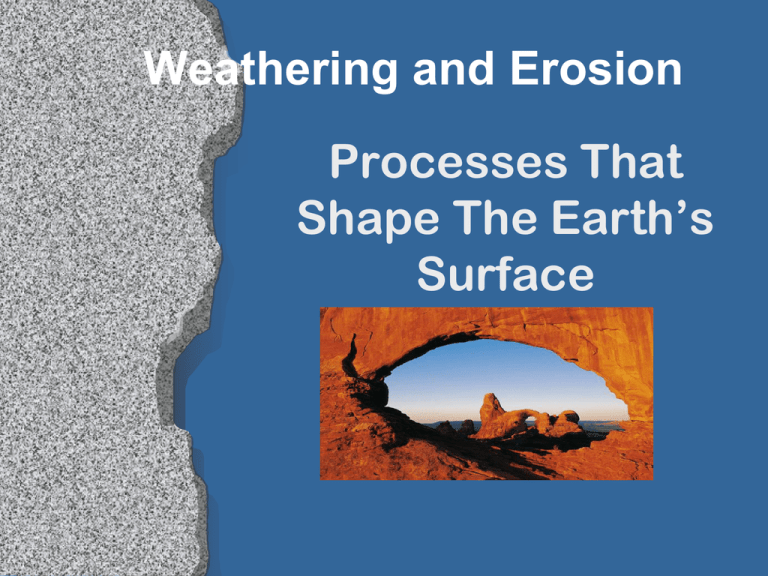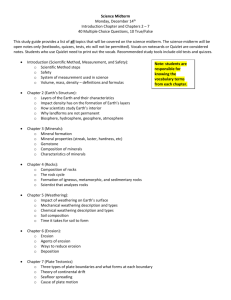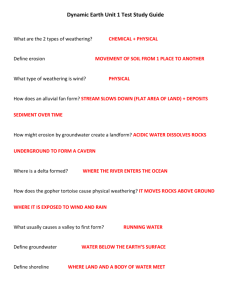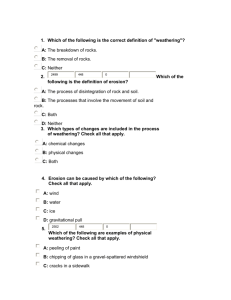Weathering and Erosion
advertisement

Weathering and Erosion Processes That Shape The Earth’s Surface Weathering and Erosion Weathering - Weathering takes place as rocks are broken down into progressively smaller pieces by the effects of weather. These pieces do not move to a new location, they simply break down, but remain next to one another. Erosion - process of removing Earth materials from their original sites through weathering and transport. Causes of Weathered Rock A large chunk of bedrock many hundreds of feet long is broken down into smaller and smaller pieces, until finally there are many tens of thousands of small rocks. Often rocks are broken down so much that they become dirt. Weathering is caused by water, as it freezes and thaws, as well as by chemical reactions that loosen the bonds holding rocks together. Weathering is most common at the surface where exposed bedrock meets the atmosphere. However, weathering can extend many thousands of feet downward into the Earth’s crust, following cracks, fissures, and microscopic holes that allow water to penetrate. Mechanical Weathering Mechanical weathering takes place when rocks are broken down without any change in the chemical nature of the rocks. The rocks are essentially torn apart by physical force, rather than by chemical breakdown. The most common type of mechanical weathering is the constant freezing, and thawing of water. This is called Frost Wedging. Frost Wedging Dome Exfoliation Rocks break off into leaves or sheets along joints which parallel the ground surface. This is usually caused by the expansion of rock due to uplift and erosion. Dome Exfoliation Biotic Weathering The word ‘bio’ means life. Thus biotic weathering is any type of weathering that is caused by living organisms. Most often the culprit of biotic weathering are plant roots. These roots can extend downward, deep into rock cracks in search of water, and nutrients. In the process they act as a wedge, widening and extending the cracks. Plant Wedging Chemical Weathering Chemical reactions break down the bonds holding the rocks together, causing them to fall apart, forming smaller and smaller pieces. Chemical Weathering can form some of the Earth’s most glorious features caves. Transport Agents That Cause Erosion Rain Streams and rivers Ocean/Beach Erosion Ice (glaciers) Wind Transport of Dust Rain Erosion Surface runoff forms when the rainfall intensity causes the soil to reach its saturation point. Stream Erosion Water flowing through a stream performs three kinds of geologic work. Moving water erodes material from the bed and sides of the channel, it transports the eroded material to a new location, and then deposits it. Stream Erosion and Deposition Ocean/Beach Erosion Beach erosion is defined by the actual removal of sand from a beach to deeper water offshore or alongshore into inlets, tidal shoals and bays. Glacier Erosion A glacier is a moving body of ice. The glacier forms when more snow and ice falls than melts and evaporates from previous years. The pressure of the increasing burden upon the snow converts the snow into ice. The glacier carries with it the dirt, gravels, rocks and boulders that it finds in its path as well as that embedded in the ice. Wind Transport of Dust Wind velocity plays a very important role in the displacement of surface soil. Wind erosion physically removes from the field the most fertile portion of the soil. Wind Transport of Dust A View From Space Weathering and Erosion Creates and Changes Landforms Canyons are formed with wind and water erosion processes. The formation of a slot canyon occurs when a channel begins to erode a joint until it is carved, cut, and forms a canyon. Arches A natural arch is basically a hole eroded completely through solid rock. Sand Dunes and Beaches Beaches are deposition landforms, and are the result of waves or currents moving the sand or other loose material. Beach materials come from erosion of rocks offshore, as well as from land erosion. Sand dunes are sculpted by wind. As long as streams flow and lakes stay wet, the sediment in them is protected. When lakes or stream beds dry out the sediment is exposed to the wind and the particles are ready to move! All it takes is a bit of breeze to put fine sand in motion. River Deltas River deltas form at the point where rivers join another body of water. A delta is formed by deposits of soil or silt wherever a swift stream or river empties into a lake, ocean, or slower river. This sediment and mud spreads out into a fan- like shape, or delta, across the mouth of the river. Caves Nearly all caves are formed from a sedimentary rock called LIMESTONE. Limestone is an easy rock to break into smaller pieces. If enough water keeps hitting the limestone, pieces will begin to break off. This takes a lot of time. Underground rivers beat against the rock to form hollows. These hollows become bigger over time until a cavern or cave is formed. Natures Masterpiece….







